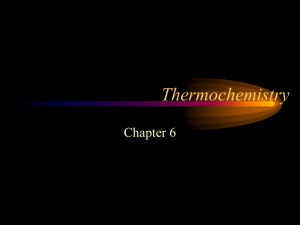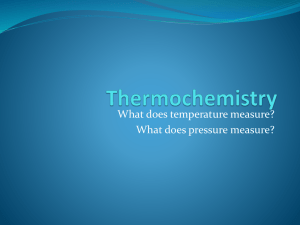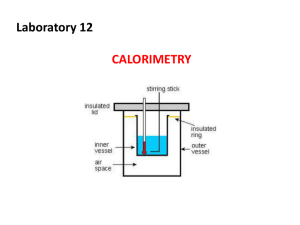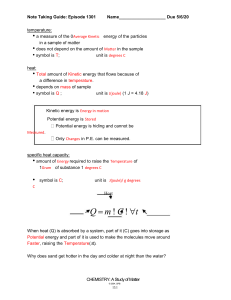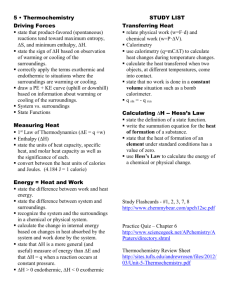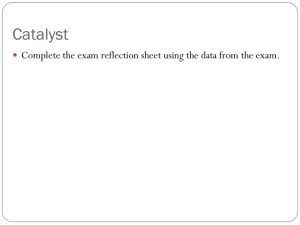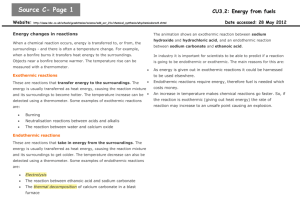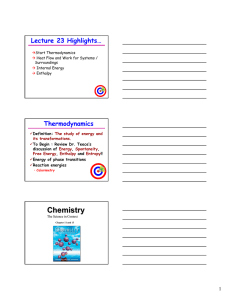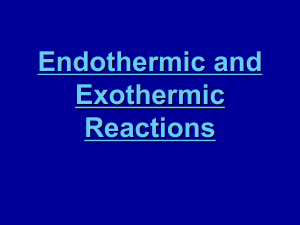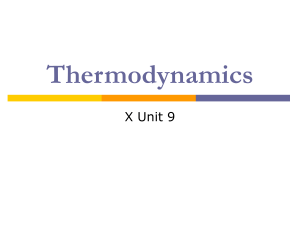Thermochemistry
advertisement
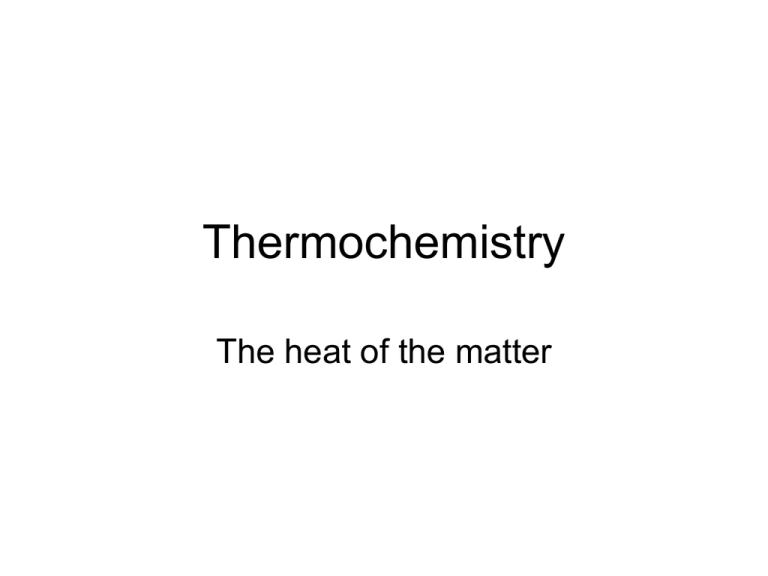
Thermochemistry The heat of the matter Energy • The capacity to do work or produce heat Law of Conservation of Energy • Energy can be converted from one form to another, but cannot be created nor destroyed. Potential Energy • Potential energy is due to position or composition Examples • Water behind a dam that may push a turbine • Gasoline Kinetic Energy • Energy due to the mass and speed of an object • KE=1/2 mv2 Heat • The transfer of energy from kinetic to heat. • Energy cannot be created nor destroyed so where does it go when the ball hits the ground? HEAT aka frictional heating Heat • Heat involves the transfer of energy between two objects observed through temperature changes Work • Work is the force acting over a distance • However, the way the energy transfer is divided between heat and work depends on certain conditions or the PATHWAY. • Regardless of the pathway, the total energy remains constant. Why? State Function • A state function refers to the property of the system that depends only on its present state. It doesn’t matter how you got there, only that you are there. • Energy is a state function. Chemical Energy • In discussing reactions we need to identify our present state. • System • Surroundings • Universe Chemical Energy • Exothermic: Energy flows out of the system into the surroundings. Expressed as (-) • Endothermic: Energy flows from the surroundings into the system. Expressed as (+) Exothermic and Endothermic Thermodynamics The First Law of Thermodynamics: • The energy of the universe is constant Internal Energy • The internal energy of a system is the sum of the kinetic and potential energies of all the “particles” in the system. The internal energy of a system can be changed by a flow of heat or work or both. ΔE=q+w • ΔE is the change in energy • q is the heat and w is the work Example • Calculate ΔE for a system undergoing an endothermic process in which 15.6 kJ of heat flows and where 1.4 kJ of work is done on the system. Result ΔE=q+w • q= +15.6kJ (endothermic) w=+1.4kJ ΔE=15.6kJ + 1.4 kJ = 17.0 kJ Work and Pressure • Work may be done by a gas (inflation) and work may be done on a gas (compression). • Pressure is Force per unit area P=F/A • Work is force applied over a distance. Work=force * distance=F * Δh (height) Work and Pressure • Since P=F/A or F=P*A then, Work = F* Δh* = P*A* Δh • This results in a change in volume, ΔV= final volume – initial volume =A* Δh • Substitute ΔV =A* Δh and Work = P*A* Δh= PΔV What about the sign of work? (+ or -) Work and Pressure • When the gas is expanding, work is done on the surroundings by the system. w= -PΔV • When the gas is compressed, work is done on the gas by the surrounding. w= PΔV Example • Calculate the work associated with the expansion of a gas from 46 L to 64 L at a constant external pressure of 15 atm. Result • w= -PΔV as the gas is expanding. • P=15 atm, ΔV = 64-46 = 18 L • w= - 15atm *18L = -270 atm To do tonight Pressure from Work
